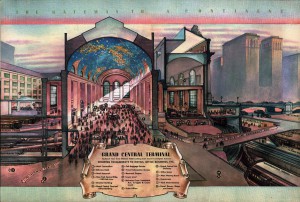Our visit to the archives was extremely interesting and one hour was not enough to browse through its offerings! Haley brought out files of photographs from the beginning of construction until the end of it (1913). She explained why the photographs differed–the blue, unclear photographs were made of a different, cheaper material (iron) and clearer ones could be made from platinum. We also got to see pamphlets and brochures from the time that gave us an idea of what was important enough to attract guests. What really caught my attention were the blueprints. There was one blueprint in particular that showed grand central terminal and all the buildings surrounding it. As Haley eloquently stated, this brings us back to the idea that the architects, engineers, and visionaries were not just creating a building but were creating a neighborhood which we consider “Terminal City.”
I also learned more about archival procedures. For example, archives reside in the basement because of the lack of windows and less humidity and it’s also imperative to wear gloves when handling items such as photographs. Sunlight, humidity, and the oil from our fingertips could damage these artifacts. Also, because we are using this for academic purposes and much of the artifacts were dated between 1923 and 1977 without copyright notice, our class is able to freely use the artifacts from the archive. This is called “fair use.” Haley also explained what the numbers on the various folders mean. An example is using “2010.20.26.10” 2010 is the year the artifact was given to the archive, 20 is the sub series number, 26 is the folder, and 10 is the collection of items that come along in that selection.
Overall, I really enjoyed our visit to the archives and hope to go back there again. There’s so much information stored in that basement and I feel like we just barely scratched the surface in the short hour we were there.
Some sources I took particular interest in are as follows:
“The Gateway to A Continent. Grand Central Zone” was published by New York in 1939. It is a pictorial spread that depicts beautiful illustrations of Grand Central Terminal and the surrounding buildings. I thought it was interesting because of the details pictures and also because it emphasized that the creating of Grand Central Terminal was the rebirth of New York City. As quoted from this source, it is a “new horizon of steel and stone” and GCT and the surrounding buildings create a “city within a city.”
“Landmarks Preservation” written by John Pyke, Jr., is a great read that argues why landmarks should be preserved, the history of landmark preservation, the New York Landmarks Preservation Commission, and the criteria for becoming a landmark/the rules. With Grand Central Terminal being a landmark and there having been a heavy dispute over keeping the building intact, I think this primary source would be excellent to use to understand the struggle over making it a landmark.
Some questions for further research to consider regarding archives and Grand Central Terminal are as follows:
- How exactly did the emergence of other methods of transportation (planes, automobiles, etc.) affect Grand Central Terminal and how did GCT compete?
- What is the process of donating artifacts to an archive?




